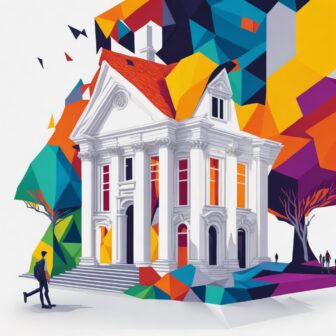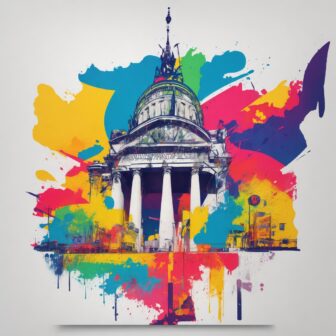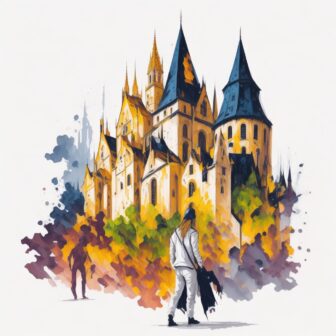Carnival in Germany – 2024 Ultimate Guide
There are many different customs and festivals in Germany. The biggest and most important holidays are Christmas and Easter. Another celebration is not a religious holiday. It is a festival called Carnival.
Carnival is not celebrated everywhere in Germany. A particularly large number of people celebrate it in the Rhineland. The carnivals in the cities of Cologne, Düsseldorf and Mainz are well known. But this festival is also celebrated in other parts of Germany where the festival is given a different name there. There it is called Fastnacht or Fasching.
Carnival in Germany – a very old custom
The custom of celebrating Mardi Gras or Fastnacht is very old. As early as the 13th century there were carnival processions and a carnival king was elected.
Carnival is a time to be really funny. You dress up and put on colorful clothes or masks.Then you go to carnival celebrations or to carnival parades with large colorfully decorated floats.
In southern Germany, but also in Switzerland and Austria, the carnival is called Fastnacht. During Shrovetide you can often see people wearing masks walking through the streets. These masks are meant to scare. You can also see witches with their brooms. Some of the figures also carry bells or whips, which they use to make a lot of noise.
This custom of the Carnival in Germany is very old. It used to be used to drive away the winter. The evil spirits that threaten growth and harvest should be scared away. And the good spirits that bring spring should be awakened. Not many people believe in it anymore. But it’s an old custom and people enjoy participating in it.
Carnival in Germany – Festivals and Pageants
Carnival is celebrated differently in the Rhineland. Much there reminds of the time of 1823. The war against the French was just over, and the first carnival parade took place in Cologne again.
Even today, many people are still wearing the type of clothes that were worn back then. Soldier’s clothes and beautiful costumes. Already on 11.11. the carnival period begins with merry parties in large houses, so-called “sessions”.
The real celebrations come in spring. For almost a week you can see people in disguise on the streets or at festivals. The highlight is a long procession with lots of colorful wagons and people dressed up on Shrove Monday. For many hours, the pageants go through the city and many people stand in the streets and watch. Schools and most shops are closed on this day.
Carnival in Germany – Going In Depth
Even today, the most colorful and creative costumes, atmospheric music and pompous sessions with funny but also political handmade speeches inspire carnival lovers in the Rhineland every year. But the carnival in the Rhineland has a long tradition. The highlight of the fifth season has always been the weekend before Ash Wednesday: from Thursday to Tuesday (this year from February 8th to 13th) the street carnival in the German strongholds on the Rhine really gets going – accompanied by colorful parades with decorated floats of music and dance troupes and disguised people, who also like to start one or the other flirtation.
A trip to Cologne, Düsseldorf or Mainz during the carnival season is definitely worth it!
Carnival in Germany – How Old is the Tradition
The tradition of carnival is very old and goes back to the ancient Germans. They dressed up in masks and animal skins and partied to awaken the good spirits and usher in spring.
In the Middle Ages, these traditions were carried over to Christianity. The idea was to really enjoy the time before the six-week Lent. Incidentally, the word carnival comes from the term “Carnevale”, which translates as “meat, farewell!”.
It was only in the 19th century, with the Napoleonic occupation of the Reihnland, that the carnival established itself as politically and socially critical, which characterizes it to this day. Because political events were banned, people met in secret and expressed what they thought about Napoleon’s politics in a critical but also amusing way.
Carnival in Germany – The Triumvirate
Incidentally, the number 11 for fools also dates back to that time. It served the purpose of jokingly disregarding the ecclesiastical order, because whoever transgressed the 10 commandments was called a fool at the time.
The carnival as it is celebrated today has its origins in 1823. At that time, the Rhineland was occupied by the French, and this occupation has now been finally lifted.
Carnival is held from 11.11. celebrated until Ash Wednesday of the following year. On 11.11. the new carnival session will be opened. Carnival sessions follow until Women’s Fastnacht. People go to these meetings in disguise. The board of directors is a so-called Elferrat, whose name is meant to be ridiculously reminiscent of the French occupation.
It is a great honor to be a member of the Elferrat. There is a lot of singing during the session.
The climax of each session is the arrival of the triumvirate, consisting of prince, farmer and maiden. The triumvirate is redefined every year. It wears splendid uniforms and consists of three men who are responsible for the period 11/11. take unpaid leave until Ash Wednesday to be able to meet all obligations.
Carnival in Germany in the Streets
From Weiberfastnacht to Veilchen Tuesday, the city belongs to the street carnival. Many shops have closed in these six days. Schools and universities are definitely closed on Shrove Monday and Violet Tuesday.
The street carnival involves all residents of the city. At all times of the day and night you will find disguised, happily partying people in the old town and in the pubs of the individual districts. The highlight of the street carnival is the Shrove Monday procession. The train consists of themed carriages, foot groups, music bands, guards and the carriage of the triumvirate. The themed cars are decorated tractor or truck trailers, which are usually designed in a humorous way to match a current topic, like politics.
Theme cars are created by clubs and groups in painstaking detail work. Often the production of the decoration takes almost the whole year. Foot groups are formed from small clubs and groups. They all wear the same costumes. Garden are men’s groups belonging to carnival associations. They wear uniforms designed to mock the French military. Instead of rifles with bayonet, they carry wooden rifles with roses in the barrel.
The passengers on the themed floats, the foot groups and the triumvirate throw sweets into the crowd standing at the side of the road. Fro example, in Cologne, more than a million people stand on the side of the road during the Shrove Monday procession. The procession leads through the city center and lasts several hours. Excerpts will be broadcast on television.
On Ash Wednesday, the Carnival in Germany will be over
The carnival ends on so-called “Ash Wednesday”. Now the 40-day Lent begins in preparation for Easter. These days, however, there are only a few people who do without certain foods and luxury foods during this time. In the past, however, this time was better endured if you had celebrated and eaten extensively beforehand.
In the past centuries, the Catholic Church has greatly encouraged and supported carnival. This was also due to the following reason: In February, the supplies that the people had stored began to run out. They would never be enough until Easter, when the first vegetables could be harvested again. Therefore, the people should celebrate, eat and drink properly during the street carnival. The period of Lent that followed was necessary to make ends meet with what little was left. Those six barren weeks were easier to endure when you had indulged in everything beforehand.
Carnival in Cologne
The origin of the Cologne carnival goes back to the Middle Ages and is still celebrated every year. 2023 is an anniversary year, because it is “Kölle Alaaf” for the 200th time and the city in the Rhineland will be transformed into a carnival stronghold.
On Weiberfastnacht at 11:11 a.m., the disguised revelers set off, the women call the shots on this day and gather on the Alter Markt.
If you like it a little more spooky, you can become part of the ghost procession on Carnival Saturday, which will parade through the city from 6 p.m. It is celebrated in honor of the Roman Empress Agrippina, who was born in Cologne almost 2000 years ago.
From 10:30 a.m. on Sunday, Cologne’s schools and district associations will parade through the streets. The highlight of the Cologne carnival is the Shrove Monday procession, which begins on February 20, at 10 a.m. in the south of Cologne. The almost 8 km long train is the largest in Germany and is celebrated by over a million people every year.
In Cologne, the carnival season is opened on the Alter Markt with well-known carnival bands and the current triumvirate. The Cologne triumvirate consists of a prince, peasants and a maiden and is the representative figurehead for the upcoming carnival campaign. Cult songs can be heard all over the city, like that of Höhner: “Da simmer mit! VIVA COLONIA!” and from everywhere it just echoes “Kölle Alaaf!”
Around 160 carnival societies, local heritage associations and neighborhood communities let the festival of festivals really rip with around 500 meetings, balls and parades.
Carnival in Cologne is one of the world’s largest and most well-known Rhenish folk festivals.
In Cologne, the days before Ash Wednesday, are busiest: from Weiberfastnacht to Carnival Tuesday, Jecke celebrate their favorite festival in colorful and impressive costumes in pubs, clubs and huge festival halls.
Things really get going on Thursday with the colorful street carnival. From now on, the whole city is on its feet! From 10 a.m. open-air sessions take place on the Alter Markt, which are even televised, with the best carnival bands that Cologne has to offer.
On Friday and Saturday evenings there will be celebrations in the pubs all over the city and Cologne carnival music can be heard everywhere.
On Carnival Sunday, the “Schull und Veedelszöch“, the school and district trains, march through the streets. The best of these foot and wagon groups can then be part of the pageant on Shrove Monday.
Shrove Monday is the highlight of the street carnival in Cologne, along with the wild women’s carnival. Around a million spectators stand on the streets to look at the floats and the great costumes and to get in the mood for the music. In addition, sweets are thrown from the wagons, and Strüßje, small bouquets of flowers, are also distributed here. They’re even more popular than the sweets!
As this carnival in Germany also comes to an end in Cologne, on the night of Ash Wednesday, on Shrove Tuesday, a man-sized, dressed straw doll is burned to act as the scapegoat. This is considered a farewell ritual and is known by the people of Cologne as Nubbelverbrennung . According to belief, every sin committed during the carnival season should be forgiven.
Carnival in Düsseldorf
Carnival is also celebrated heavily in Düsseldorf. Similar to Cologne, the carnival begins at 11:11 am on Weiberfastnacht and the Möhnen storm the town hall. Hundreds of thousands of visitors gather on the Königsallee and in the old town to celebrate on Carnival Sunday.
“We celebrate life” is the Düsseldorf carnival motto for 2023. The fifth season in Düsseldorf is known for numerous carnival sessions, costume balls and the annual television broadcast. Smaller Veedelszoch moves have also established themselves in Düsseldorf. The most traditional is the barrel race in Niederkassel.
On November 11th it is that time again, because it is called “Hoppeditzer Wache“: On the market square in front of the town hall in Düsseldorf, the Archschelm Hoppeditz woke up and got out of his mustard pot.
Hoppeditz is traditionally one of the most important figures in the Düsseldorf carnival. Year after year, with his pointed and amusing opening speech, he challenges the mayor to a foolish battle of words and heralds the beginning of the carnival season. From this moment on, you can laugh, dance and sway again in Düsseldorf – in other words: “Düsseldorf Helau!”
Every year, the carnival season in the carnival strongholds has its own motto, this year it’s “Jeck even more”, under which the amusing ceremonial sessions and costume balls also take place. In addition to humorous speeches, impressive dances by Tanzgarden and atmospheric music, the performance of the Düsseldorf royal couple is the highlight of every session.
On Weiberfastnacht, the city belongs to the women: every year on Carnival Thursday, carnivalists storm the town hall. Countless ladies in disguise “ambush” the men at work and cut off their ties – whether they like it or not!
And also on Carnival Sunday things are wild in Düsseldorf. Crowds of people in fancy costumes come together in the old town and on Königsallee to celebrate the popular festival together!
The next day, the Shrove Monday procession is already waiting for the starting signal. With around 72 wagons, over 30 chapels and around 5.1 kilometers in length, it is one of the largest in Germany. Hundreds of thousands of people watch the parade, hoping to catch a camel or two thrown off the floats.
The foolish tattoo is on the program on Carnival Tuesday and marks the end of the foolish festival. Then the mayor and the president of the Comitee Düsseldorfer Carneval officially say farewell to the royal couple. However, the carnival season is not really over until Ash Wednesday. The symbolic burning of Hoppeditz finally signals the end and Lent begins.
Carnival in Mainz
The Mainz Fastnacht is one of the largest and most diverse folk festivals in Germany. Alongside Cologne and Düsseldorf, Mainz is also one of the carnival strongholds in Germany.
Become part of this festival and celebrate together with other fools at the event “im Saal un uff de Gass“. The opening of the women’s carnival begins on Thursday, February 16, at 11:11 a.m. at the carnival fountain. Dress up and then continue partying with the stage program at Schillerplatz.
On Shrovetide Sunday you can admire the parade of jester guards and at 1:11 p.m. the Dance on the Lu takes place at the Shrove Tuesday fountain.
The Mainz Rose Monday parade begins on February 20, also at 11:11 a.m. and ends with the Rose Moon Night from Narrenturm to Narrenturm on the “Lu”.
Meenzer Fastnacht is true to this motto.
Also on November 11th, the foolish basic law was proclaimed on Schillerplatz in Mainz as the starting signal for the beloved and above all fun time and the carnival season was ushered in to the beat of the famous Narrhalla march.
With the New Year’s parade of the Garden, which traditionally takes place on January 1st, the coveted carnival season in Mainz really starts. The fools meet every weekend up to the women’s carnival to take part in the famous carnival sessions. Tradition holds that each session must begin exactly 11 minutes past the hour. Only then does the Elferrat move into the festively decorated hall in pomp and glory.
On the Thursday of Carnival, the time has finally come – the old women’s carnival will be opened at the Mainz carnival fountain .
It then continues on Shrove Tuesday with the swearing-in of recruits, in which an oath of allegiance to the Guard and Shrove Tuesday is taken on an oath derived from Prince Carneval.
However as before in Düsseldorf and Cologne, the highlight of the atmospheric and humorous festival is the Shrove Monday procession, which transforms the city center into a colorful sea. In Mainz, too, colorfully decorated floats, marching bands and guards parade through the city on this day. But, something must not be missing here: the Meenzer Schwellköpp. These are oversized papier-mâché heads that embody the Mainz characters in a satirically exaggerated way.
Finally, on Shrove Tuesday, the foolish hustle and bustle is completed with a cap ride. In numerous pubs and on Ludwigstrasse, Mainz residents say goodbye to the Kampagne until next year and bury it.
RELATED
Best Time to visit Germany
Carnival in Cottbus
The Cottbus Carnival is the largest carnival parade in East Germany and is celebrated vigorously. More than 3,000 people are part of the so-called “train of the happy people” and will be moving from 1:11 p.m. on February 19, 2023 from Franz-mehring-Strasse to the cattle market.
The procession is led by the triumvirate, the prince couples and dancing Funkemariechen. Here not only camels are thrown, but also Spreewald gherkins, pancakes and quark balls are distributed to the spectators.
Almost 200 clubs and associations from all over Germany take part in the carnival parade in Cottbus and present their colorfully decorated floats. Anyone who is still in a party mood after the train can continue celebrating on Carnival Sunday from 4 p.m. in the tent at the huge party. Admission is free.
Carnival in Munich
From February 19 to 21, 2023, Munich‘s entire pedestrian zone will be transformed into a single party mile. At “München narrisch” people sing, dance and laugh.
Carnival societies and various organizers make the carnival days in the Bavarian capital perfect. Immerse yourself in a colorful world with an open-air atmosphere and dance performances from the Stachus to the Viktualienmarkt. You can experience show acts and other surprise programs on three stages, as well as DJs and moderators
RELATED:
Best Places to Visit in Munich
Best City Breaks in Germany
Carnival in Aachen
Similar to Cologne, the motto in Aachen is “D’r Zoch kött!” and everyone knows it’s that time again: the carnival parade begins. The Shrove Monday parade 2023 begins punctually at 11:11 a.m. on February 20th and moves through the streets of Aachen. Hundreds of thousands of people celebrate colorfully and exuberantly, making the street carnival a very special event.
Become part of this festival and admire the more than 160 groups that parade through the streets of the old imperial city with music and floats. With a total length of more than 6 kilometers and over 5000 participants, the Aachen Carnival Monday procession is one of the ten largest in Germany.
Carnival in Bremen
The Bremen Carnival is no ordinary carnival as we know it from the Rhineland. In the Hanseatic city, Samba is the focus of the Bremen Carnival, with the motto changing every year.
Then the city center is transformed into a colorful sea of costumes and hot samba rhythms, and around 100 dance groups from Germany, Denmark, England, the Netherlands and Switzerland parade through the city.
Almost 40,000 visitors a year follow this colorful spectacle. It’s not about Kamelle, Helau and Alaaf, but the mask play, the art of dancing and acrobatics are in the foreground.
Carnival in Stuttgart
While political topics are often used as a motto in Düsseldorf and Cologne, the Stuttgart carnival is usually less political and the joy of celebrating is in the foreground.
Traditionally, the big parade takes place on Shrove Tuesday, where more than 2000 revelers take part. Every year, hundreds of thousands of visitors parade through the streets of the Swabian metropolis in disguise and party wildly.
At 12 o’clock all revelers gather at the starting point of the procession, in Friedrichstrasse and Kronenstrasse, and the parade begins. There will be an extra parade for children at 2:30 p.m. in Marktstraße, in which around 500 children will take part and fight for the so-called “wooden moon mask”, divided into different groups.
Carnival in Nuremberg
The carnival procession in Nuremberg traditionally takes place on Shrove Sunday. Almost 100,000 visitors gather in Nuremberg and admire the colorful procession, which begins at 1 p.m. on Bayreuther Strasse and ends at the White Tower.
The highlight of the Nuremberg carnival is the children’s parade on Shrove Monday, which winds its way through the city center from the Lorenzkirche from 12:30 p.m. The procession is led by the children’s prince couple, accompanied by music and boys and girls from various institutions who are enthusiastic about dressing up.
Carnival in Frankfurt
Carnival lovers are not only in good hands in the Rhineland, but also in Frankfurt am Main there is a lot of hustle and bustle.
On Shrove Sunday, Frankfurt’s procession moves through the streets of the city center. The train begins at 12:11 p.m. at the Rotfeder-Ring and ends after three and a half kilometers at the Mainkai.
More than 90 clubs and associations and almost 3000 participants come together to celebrate the fifth season with music, parties and dance. There will be a grandstand on the Römerberg in the old town, where carnival lovers will get their money’s worth.
Carnival in Germany but a Bit Different
There are also a lot of people who enjoy dressing up but prefer to celebrate the season in a modern way, away from the old traditions. And of course that is also possible!
Modern and hardly traditional carnival parties for all disguise and theme party lovers can actually be found in every carnival stronghold and in many other cities in the area. From the small indie club to the large discotheque, almost every party location takes the carnival season as an opportunity to throw big parties with colorful costumes and turn night into day.






